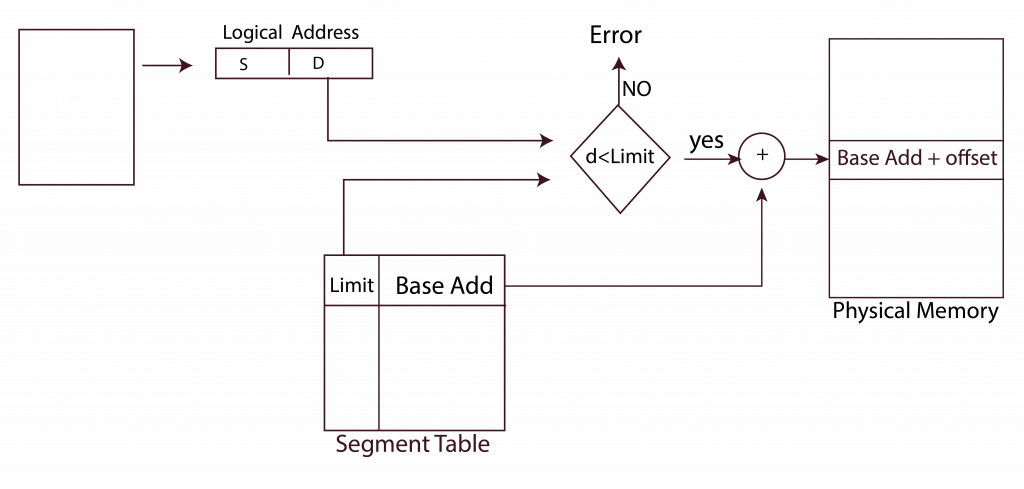The Operating System uses the segmentation technique to divide a program’s memory into different segments, and every segment represents a logical part of a program. Segmentation divides memory into variable (non-fixed size) segments based on the program’s logical structure while paging divides memory into fixed-size pages. And this is what’s explained in this article about the segmentation and the benefits.
What is Segmentation in OS?
Segmentation in an Operating System is a memory management technique that divides a program’s memory into segments based on its logical structure, such as code, data, and stack. Each segment can vary in size and is managed separately, allowing for more efficient memory use and better organization of program components.

POSTGRADUATE PROGRAM IN
Multi Cloud Architecture & DevOps
Master cloud architecture, DevOps practices, and automation to build scalable, resilient systems.
Why is Segmentation Required?
It is important in the operating system to partition the memory into units, such as source code, data, and stack, as used in programming. This method is helpful in minimizing memory utilization, minimizing memory fragmentation, and making it easy to manage addresses through two-level addressing. Additionally, segmentation increases safety through diverse permissions for every segment, such as making the segment containing source code readable as executable but not as a writable segment. It also enhances multi-user operation since memory is independent of the user, making multiple tasks much easier. In general, I can say that with the help of segmentation, memory is managed more efficiently, and performance improves. It makes it easy to achieve modular programming.
What is a Segment Table?
- This table stores the information about all the segments of a process.
- The segmentation table helps to map two-dimensional logical addresses to the physical addresses.
- This is stored in the main memory.
- There are two entries in the Segment Table.
Base Address: The starting physical address of the particular segment inside the main memory.
Limit: This denotes the size of a particular segment.

Also Read: Fragmentation in OS
Types of Segmentation in Operating Systems
There are two types of segmentation in the Operating System. Let’s discuss each one individually.
- Virtual Memory Segmentation: In virtual memory segmentation, each process is divided into multiple segments, and all of them do not reside at one point at a time.
- Simple Segmentation: This is a simple segmentation process divided into multiple segments, all loaded into memory at run time. It cannot be contagious.
Also Read: Difference Between Paging And Segmentation

82.9%
of professionals don't believe their degree can help them get ahead at work.
Advantages of Segmentation in Operating System
Let’s discuss the advantages of segmentation in the operating system.
- Efficient Memory Utilization: Segmentation allows for variable-sized memory that blocks to match the size of each segment. It reduces internal fragmentation, where memory is wasted inside allocated space. Each segment is allocated memory based on its size, leading to more efficient use of memory resources.
- Logical Organization of Memory: Segmentation reflects the logical structure of programs. The different parts of a process, such as code, data, and stack, are stored separately in memory. This makes the program easier to manage, debug, and optimize. It also improves the readability of the memory layout from the programmer’s perspective.
- Protection and Isolation: Each segment can have different access permissions (such as read-only, write, or execute). This ensures that sensitive parts of the program (like the code segment are protected from unauthorized access or modification, enhancing security and program stability. For example, making the code segment read-only prevents accidental overwriting.
- Sharing of Segments: The segmentation supports memory sharing, which is particularly useful for sharing source code or data segments between multiple processes. For example, multiple programs can share a common library or data segment without duplicating memory, thus saving space and improving efficiency.
- Supports Modular Programming: Since segments represent logical units, segmentation naturally supports modular programming. This structure allows for better management of program components, with each module stored in a separate segment, improving development and maintenance efficiency.
Disadvantages of Segmentation in Operating System
Let’s discuss the disadvantages of segmentation in an Operating System.
- External Fragmentation: Segmentation can lead to external fragmentation because memory is allocated in variable-sized segments. Over time, as segments are created and deleted, free memory blocks may become scattered throughout the system. This fragmentation occurs when there is enough total memory available, but it is not contiguous, making it difficult to allocate to new segments.
- Complex Memory Management: Managing variable-sized segments is more complex than managing fixed-sized pages, as in paging. The operating system needs to keep track of the size and location of each segment, which can increase overhead. Additionally, more sophisticated memory allocation algorithms are required to handle the dynamic nature of segments.
- Segmentation Faults: A segmentation fault occurs when a program attempts to access memory outside its allocated segment. Segmentation separates memory into logical units. Any attempt to access memory beyond the segment’s limit results in a fault, crashing the program.
Conclusion
The segmentation is a crucial memory management technique in operating systems that enhances the flexibility and efficiency of memory allocation. By dividing a program’s memory into variable-sized segments based on logical divisions such as functions, data structures, and objects, segmentation allows for more intuitive organization and easier memory management. The key features, such as logical segmentation, dynamic size allocation, and improved protection and sharing of resources, contribute to its effectiveness.
What is segmentation in an Operating System?
What is a segment table?
Can a segment be shared among multiple processes?
What is the purpose of a base register in segmentation?
Can segmentation be used in embedded systems?
Updated on October 15, 2024
